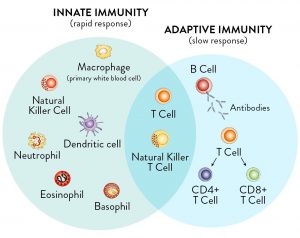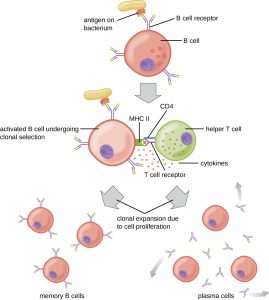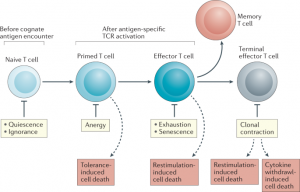36 1.2: Introduction to the Immune System
Introduction to the Immune System
The immune system is made up of a number of organs, cells, and networks that work together to fight pathogens such as bacteria and viruses (Johns Hopkins 1). There are two parts of the immune system. You are born with an innate immune system and this is the bodys first response to a pathogen or infection which acts immediately (Johns Hopkins 1). Cells called macrophages are phagocytes and recognize proteins or receptors on the pathogens cell membrane that are similar to many bacteria or viruses (Janeway 1). Macrophages can engulf the pathogen and secrete cytokines an chemokines, which can alter the activities of other innate immune cells such as neutrophils (Janeway 1) .Cytokines specifically can communicate with other cells through autocrine, paracrine, or endocrine signalling and can be pro or anti-inflammatory (Zhang 1). The processes of innate immunity can induce inflammation which can create heat, redness, or swelling at the site of infection (Janeway 1).

Definitions
Phagocytes– Are a type of immune cell which can phagocytose (eat/engulf) pathogens that enter the body, including bacteria, or dead cells. Phagocytes include the immune cells macrophages, dendritic cells, and granulocytes.
Thymus-Is a primary lymphoid organ of the immune system located near the base of the throat. The thymus is where T cells mature.
Antigen presenting cell (APC)– Are cells that present antigens on their cells surface towards T cells, known as antigen presentation.
The adaptive immune system develops over time and acts in a slower and longer manner. The adaptive immune system is made up of immune cells called B cells which develop in the bone marrow, and T cells that develop in the thymus (Janeway 1). Dendritic cells ( a type of phagocytic cell) begin the adaptive response by surveying the environment for pathogens, and then ingesting them by recognizing common features that many pathogens share, therefore maturing into an antigen presenting cell (APC) (Janeway 1). APCs cant then activate pathogen specific T lymphocytes. T cells can further differentiate into CD4+T-cells which are helper T cells which can activate B cells, or CD8+ T-cells, which are cytotoxic and kills infected cells (Janeway 1).A helper T-cell activates B cells in order for them to make cell-specfic antibodies with a unique antigen binding site (Alberts 1). Antibodies come in 5 different isotypes including IgG, IgM, IgA, IgE, and IgD, which act in different types and in difference stages of the immune response (Thermo Fisher Scientific 1). B cells can then differentiate into plasma cells that will secrete antibodies or memory B-cells which create an antibody mediated response to re-infection(Thermo Fisher Scientific 1). The Adaptive immune system is able to recognize millions of different pathogens, and creates a specific, and long lasting response to each pathogen through immunological memory.


Test your knowledge:
